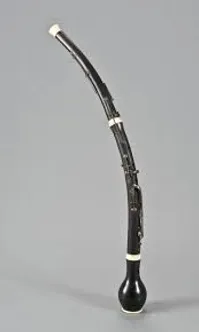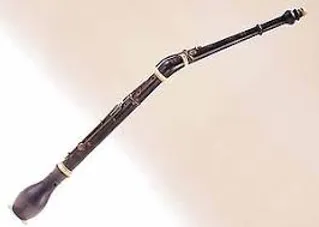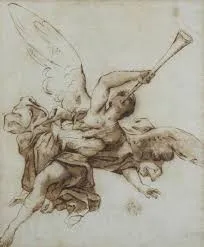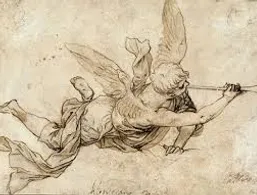The emergence of the Cor Anglais/English Horn
The oboe da caccia (hunting oboe, hautbois de chasse/de forêt), likely invented by J.H. Eichentopf of Leipzig, Germany,was played between 1720 and 1760 in some parts of central Europe, mainly Germany. This sharply curved tenor oboe in F with a flaring bell was made out of a single piece of wood and covered with leather. The curved shape was achieved by cutting out wedges and then stretching the instrument over an arch. The flaring bell gave it an overall appearance reminiscent of a horn, hence the name. The most famous part written for this instrument is Johann Sebastian Bach’s St. Matthew Passion, in which two oboi da caccia (and one transverse flute) accompany a soprano aria.
The modern English Horn/Cor Anglais was developed in around 1720, probably in Silesia (at the time part of the Austro-Hungarian Empire), by adding a pear-shaped bell to the oboe da caccia. The oboe maker J. T. Weigel was evidently one of the first to make such a ”Cor Anglais”, as the instrument was known. The keywork was the same as on the oboe, the reed was fixed on a short, curved, small pipe. In the course of the century the shape became less curved, until by the end of the century an angular form of the instrument had established itself too. This form remained popular for decades afterward.
Why “English” Horn or Cor "Anglais" ?


The Horn part of the name is most probably derived from the brass horn-like shape of early tenor oboes, especially the oboe da caccia. The English part of the name it seems, was used because the instrument resembled the horns with which angels were depicted in religious illustrations from the Middle Ages and thereafter. In Middle High German the word engellisch meant angelic. The modern German word engel = angel in English - deriving from anjali (Sanskrit for offering) and angelos (Greek for message from the gods). At the same time, however, it also meant ”English” as it was the "Angle" or "Angli" tribe (purportedly deemed to be Angelic because of their blonde hair and fair complexion) from Northern Germany who invaded England in the 5th century and thus gave their tribal name to England as well as the word Englisc, used even by Saxon writers to denote their vernacular tongue. This may explain how the latter adjective came to be applied to the instrument after the disappearance of the early tenor oboes.
Another theory suggests that the French term cor anglé (”angled horn”), which described the angled instrument, became Cor Anglais (”English Horn”) over time. However, it is likely that the name English Horn was in use before the angled form of the instrument appeared (in around 1790).
So maybe it is time to restore the instrument to its more rightfully descriptive name - possibly Angelic Horn or Cor Angélique? I find it interesting that two of the three main 19th century solo chamber music parts composed for the cor anglais had the cor anglais paired with a harp - Pasculi's 'Hommage a Bellini' and the newly discovered work by Liszt.
The Cor Anglais/English horn in the orchestra
Niccolò Jommellis paved the way for the admission of the English horn into the orchestra with his Ezio, premiered in 1749 in Vienna. Initially the instrument was always used in pairs. One of the first composers to use the English horn/Cor Anglais regularly was Christoph Willibald Gluck, who first scored for it in La danza (1755). Haydn scored 2 Cor Anglais in his symphony no 22 'The Philosopher' 1764. The Cor Anglais subsequently gained great popularity in Italian opera, in which it was given the task of performing lyrical and vocal-like parts e.g., Rossini's 'William Tell Overture', Donizetti's 'Maria Stuarda', Bellini's 'Il Pirata', Verdi's 'Otello' and 'A Masked Ball'. Italian opera houses were established in many European cities, including Vienna, Munich, Dresden, Hamburg, Milan, Venice, Naples and Lisbon. It was also in these cities that the makers of Cor Anglais set up their workshops.


At the beginning of the 19th century French musicians began to take an interest in the new-style low-pitched oboe, too. The virtuosity of the oboist and cor anglais player Gustave Vogt (1781–1870), a professor at the Paris conservatoire, inspired several composers to write outstanding parts for the English Horn/Cor Anglais, Hector Berlioz (Carnival Romain, Rob Roy Overture, Symphonie Fantastique and L'Enfance du Christ) and Saint Saens (Symphony No. 3 in C minor, Op. 78 the Organ Symphony).
The Cor Anglais/English horn in chamber music
The Bohemians enthusiastically embraced the Cor Anglais/English horn. The Schwarzenberg Harmonie particularly choosing the instrument over the modern at the time, western european clarinet, which resulted in the opportunity to compose the first oboe trios for the brothers Teimer. It appears that the Schwarzenbergs did also commission some Wind Harmonie compositions for their particular line-up. In the small time I had after photographing all the oboe trios I found octets by Salieri, Went and Triebensee scored for 2 oboes, 2 cor anglais, 2 horns and 2 bassoons. The Lonarc Foundation are hoping to discover more of these through their research and then edit them for publishing.
It is known that Johann Went wrote a Partitha in D minor for 2 oboes, 2 cor anglais, 2 bassoons and 2 horns and that Josef Triebensee wrote a Grand Quintet for wind and piano that is scored for a cor anglais instead of an oboe.
With initial researches of the Imperial Library of Vienna we have discovered a Quartetto Concertante by Went for Oboe, Oboe Grande (in G - but could be transposed for Oboe d'Amore), Cor Anglais and Bassoon and numerous oboe quintets (oboe, violin, 2 violas and double bass) by Went and Triebensee.
Text copyright © 2015, Vienna Symphony Library. http://www.vsl.co.at/en/English_horn/History and https://www.britannica.com/topic/Angle-people with additional comments by Judy Proctor 2017

